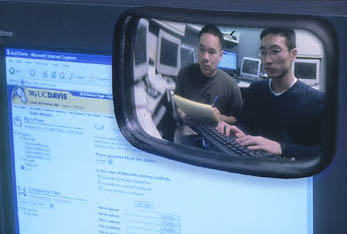|
|
How MySpace Became a Lesson Plan
Student Involvement in UC Davis Portal Development
What's different about your approach to English 104A? Besides covering some of the standard forms of writing like letters and memoranda, my courses feature group work on real-world projects: students take on documentation and report-writing tasks that benefit themselves and the campus community more broadly. Student-written documentation from my courses for the UC Davis WebChat utility is now being distributed over the Web, folded into a section of the Computer Classroom Instructor's Guide I published, and has even contributed to changes in the student modem bank, the Aggietraks job-information service, and the MyUCDavis interface.
What do you mean by "documentation?" What does one of your assignments look like? Documentation is like the instruction manual for a program or a computer function. If the documentation is good, a user should be able to work step-by-step through the program or interface, anticipating common errors while maintaining a logical flow. I have my students "test-drive" new feautures on MyUCDavis, checking to see how effective the documentation is at helping them navigate around. They then write the instructions that would furnish a typical user with enough info to get the job done. It sounds as if you expect a lot. What about students who come to your classes without a great deal of computer expertise? I have found that some of the most valuable members of my tech-writing classes are smart students without extensive computer skills, who ask common-sense questions and point out flaws in interface design that would escape the notice of the "experts." What are some specific ways MyUCDavis has benefited from this kind of student work? Well, user input is always beneficial. My students who looked at the first rollout were adamant about making some MyUCDavis features optional rather than automatic. The "customizability" of our portal is key, and so is the flexibility of the tool itself. My latest set of students looked at MySpace, which takes the portal to another level of usefulness, since it allows students, faculty, and staff to drop off large files for each other right on MyUCDavis. Anybody who has ever hassled with floppy disks or email attachments or tried to find a Zip drive-equipped computer can appreciate how important the MySpace online file storage utility is going to be. And even the beta version looked really promising. But there is always room for time-saving improvements. Each of my two classes last quarter wrote end-user documentation and their reports offered the MySpace Development Team advice on how to improve the overall design and make the interface more self-documenting and intuitive to use. In effect you were also test-driving the utility itself, weren't you? Yes, actually that was one of the coolest aspects of the quarter: students were using MySpace itself to write about MySpace. They'd say, "Hey, this 'File Friends' feature could make it easier for my project partner, who lives in Concord, to swap drafts with me." Then I invited members of the MyUCDavis Development Team who created MySpace to meet with each class for a Q & A session, and everyone learned something. How do you know your student-generated reports get read? A nice vindication came for me when a new administrative member of the Academic Computing Coordinating Council cited student work to make a point. How did you get interested in this sort of work? Though the microcomputer revolution and the explosion of the Web have put computers in the hands of millions, there's still a serious communication gap between users and providers. I try to address these problems on a broad variety of fronts, and harnessing student curiosity and self-interest seemed a logical way to do it. Any parting words about your obvious enthusiasm for getting involved? I think everyone involved in this project knows how much easier this whole MyUCDavis portal can make our lives. Some of my colleagues (Rod Romesburg and Raquel Scherr) are working with students on similar projects. To make MyUCDavis the best it can be, the technology producers have to consider the input of the users. I like contributing to the improvement of technology implementation, and I'm truly excited about what's to come. |
